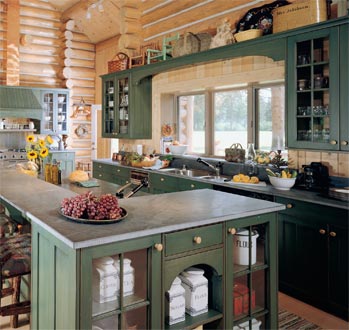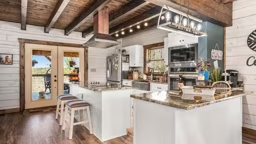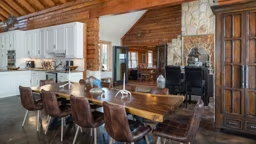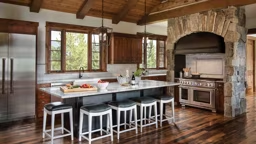 Whether you're baking your famous seven-layer cake or just fixing yourself a grilled cheese sandwich, you'll want a kitchen that's well designed—and well stocked. That can be a big investment, since most experts recommend spending 7 to 15 percent of your log home building budget on the kitchen alone. As with any room, there are ways to cut corners without ruining the entire recipe. Read on for a collection of classic tips for costeffective kitchens.
Whether you're baking your famous seven-layer cake or just fixing yourself a grilled cheese sandwich, you'll want a kitchen that's well designed—and well stocked. That can be a big investment, since most experts recommend spending 7 to 15 percent of your log home building budget on the kitchen alone. As with any room, there are ways to cut corners without ruining the entire recipe. Read on for a collection of classic tips for costeffective kitchens.Cabinet Creativity
• Add a cherry finish on maple cabinets instead of splurging for real cherry.
• Instead of spending big bucks on custom cabinets, enhance stock or semi-custom cabinetry by adding crown molding or vinyl-covered rigid foam.
• You can also dress up stock cabinetry with glass doors. Inside, opt for affordable wood veneer, which can be stained to match the wood outside.
• Installing cabinet doors yourself can save you $50 to $75 per cabinet. French Country fans replace some doors with a decorative curtain rod and fabric for a distinctive (yet inexpensive) look. Or leave some open for tasteful displays of your favorite serving pieces.
• In lieu of costly built-in organizers, shop around for lazy Susans, spice racks and other sorting systems.
• If you splurge on fine hardwood cabinets, add your own hardware. Home centers and department stores stock decorative knobs and pulls for just $1 to $25 apiece.
• For an upscale look at a midrange price, vary the heights of your cabinets, such as pairing two corner 42-inch wall cabinets with standard 36-inch cabinets.
Kitchen Staff
• Look for Energy Star®-compliant appliances to increase your kitchen's efficiency. Some areas in the United States and Canada offer a rebate or tax credit for buying these energy-friendly essentials. Also look for the yellow Federal Trade Commission Energy Guide label, which is required on appliances like refrigerators and dishwashers, to compare the efficiency of different units.
• When selecting appliances, compare the cost of various models by looking at important details, such as a microwave's power output, the number of spraying arms in a dishwasher, and the storage capacity of a refrigerator/freezer. Use "bells and whistles" as a deciding factor only if they'll make a difference in your day-to-day life.
• Because even the best appliances can eventually break down, consider the value of each model's warranty along with its price. What's the term length? Which parts are covered? Is labor included? Will it be honored by other dealers?
• You may not need to give up on Old Reliable. Dressing up your existing refrigerator and dishwasher with wood panels can give them new life at a reasonable price.
• Stacked fridges/freezers are generally less expensive than side-by-side models—particularly with the freezer on top.
• Although they're often more expensive than electric ovens, gas ovens operate more efficiently in the long run. Infrared broilers are most efficient of all because they heat up fast.
Counter Measures
• Laminates are a less-expensive alternative to popular granite and stainless steel counters. They are easier to maintain, come in many styles, and can be personalized with wood or tile trim. But note: laminates aren't as durable as stone and can't be repaired. So they may be perfect for a vacation home, but may not be ideal for serious cooks or big families.
• If you're really on a budget, plywood counters can look great with quality stains and finishes. Consider them "starter" counters and remodel in a few years.
• Decorative edges are another stylish detail for cost-conscious kitchens. It costs more to add this detail to a stone counter than a laminate one.
• Still determined to use granite countertops? Look for construction-grade granite that has more flaws but is priced lower than residential grades. Another option: use smaller granite tiles instead of a large single slab.
• If you choose steel or stone surfaces in your kitchen, mix them up with reasonably priced countertop materials like butcher-block wood or ceramic tile surfaces.
• A kitchen backsplash can be a dramatic and inexpensive kitchen accent. Ceramic, stone, glass or metal tiles are available in tile shops and kitchen showrooms, or you can buy them for a little less at home improvement stores.
• If you're looking to economize on space, try a mobile worktable with locking wheels. It will give you the surface area you'd get from an island without permanently stealing from your floor space.
• Speaking of islands (and peninsulas), they can do double duty. Multitask with a well-configured bar that can be used for food preparation, casual dining, entertaining and even homework.
Cooking Light
• Task lighting shines light exactly where you need it. Fluorescent lights are the least expensive—and compact fluorescent lights (CFLs) largely eliminate the poor color, flicker and noise of traditional fluorescent lights.
• Hidden under-counter lighting—which is great below the kitchen sink—is a functional powerhouse that can cost as little as $50.
• Good window design and placement will bathe your kitchen in 100-percent-free sunlight. [Bonus: this can make a smaller kitchen feel bigger.]
• If you plan to add curtains, choose something sheer or light in color for maximum solar power.
Unsinkable Savings
• Undermounted sinks (where the bowl is attached beneath the counter) are the most affordable sink option—and generally also the easiest to clean.
• In terms of material, stainless steel is the most popular choice—and also the least expensive. [A more luxurious choice would be copper.] Look for at least 20-gauge steel (18-gauge is even thicker/better) to resist dents and reduce noise.
• For optimal corrosion resistance, look for a stainless steel blend of 18 percent chromium and 8 percent nickel. To save a little dough, consider brushed chrome instead of nickel.











